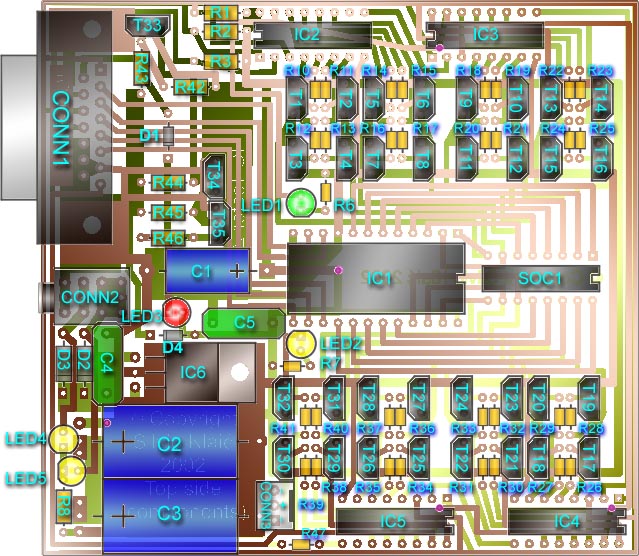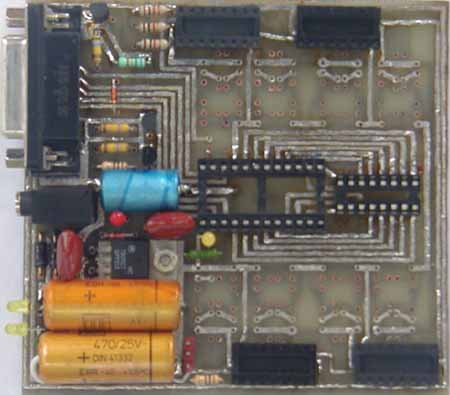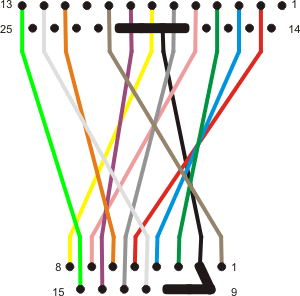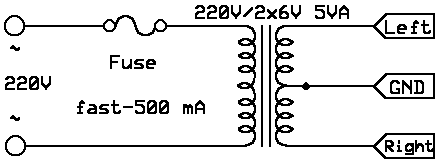

Assembling |
ICT device |
Testing |
Program |
IC Tester is electronic device for testing ICs (integrated circuits) and may test some others electronic elements with appropriate addon.
Device is connecting to parallel (printer) port at computer, currently you can connect it to PC and Amiga computers.
| Part No | Part Type | Amount required |
| IC1 | SN 74150 | 1 |
| IC2-5 | CD 4094 | 4 |
| IC6 | 7805 | 1 |
| T1-34 | BC 547 (or similar) | 34 |
| T35 | BC 558 (or similar) | 1 |
| D1, D4 | 1N4148 | 2 |
| D2-3 | 1N4002 | 2 |
| LED1 | Green, 3 mm | 1 |
| LED2, LED4-5 | Yellow, 3 mm | 3 |
| LED3 | Red, 3 mm | 1 |
| R1-3 | 1 kOhm | 3 |
| R6-8 | 5,6 kOhm | 3 |
| R10-41, R46-47 | 100 Ohm | 34 |
| R42 | 75 kOhm | 1 |
| R43 | 560 kOhm | 1 |
| R44-45 | 470 kOhm | 2 |
| C1 | 330 uF/10V (microF) | 1 |
| C2-3 | 470 uF/25V (microF) | 2 |
| C4-5 | 100 nF | 2 |
| CONN1 | DB 15 female, right angle | 1 |
| CONN2 | 3,5 mm stereo headphone jack | 1 |
| CONN3 | 3 pin male single line connector | 1 |
| SOC1 | DIL 16 pin socket (long pins) | 1 |
| Other | DIL 16 pin socket | 4 |
| Other | DIL 24 pin socket | 1 |
| Parts for data cable | ||
| Other | DB 15 male connector | 1 |
| Other | 12-15 wire regular cable | 1-2 meters |
| Other | DB 25 male connector | 1 |
| Parts for power | ||
| Other | 3,5 mm stereo headphone connector | 1 |
| Other | 3 wire regular cable | 1-2 meters |
| Optional | Transformer 2x6V/5VA | 1 |
| Optional | 2-3 wire regular power cable | 1-2 meters |
| Optional | Fast fuse 500mA | 1 |
| Optional | 9V power connector | 1 |
Something about price, by my estimation all listed parts in table should cost about 25 dollars.
In that price isn't included price of printed board and optional parts, in most cases you probably make this board by yourself.
In that case you should spend about 5 dollars, otherwise you can spend up to 30 dollars.
When you manually making board, in PDF document are printed board layouts, when printing check that Fit to page
option isn't checked to get ratio 1:1. If you need change something on board, use PCB file with appropriate free software to
modify it. See download section.
Dimension of board is 100 by 93 millimeters, +/- 1 millimeter variation isn't catastrophic important is that holes for IC1 to
IC6 match.
On picture below is IC Tester 2 schematic (click on image to enlarge):




